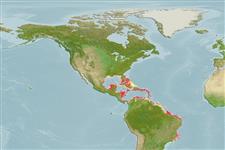Common names from other countries
>
Eupercaria/misc (Various families in series Eupercaria) >
Labridae (Wrasses) > Corinae
Etymology: Halichoeres: Greek, als, alis = salt + Greek, choiros = pig (Ref. 45335).
More on author: Steindachner.
Environment: milieu / climate zone / depth range / distribution range
Ecología
marino asociado a arrecife; rango de profundidad 1 - 70 m (Ref. 9710). Tropical; 30°N - 33°S, 98°W - 31°W
Western Atlantic: southern Florida, USA and the Bahamas to São Paulo, Brazil (Ref. 57756).
Tamaño / Peso / Age
Maturity: Lm ? range ? - ? cm
Max length : 20.0 cm TL macho / no sexado; (Ref. 7251)
Espinas dorsales (total) : 9; Radios blandos dorsales (total) : 11; Espinas anales: 3; Radios blandos anales: 12. Small individuals yellowish green with a black spot, edged in light red, behind eye; a small black spot at rear base of dorsal fin. Large adult males are dull green, the centers of the scales with a dull orange red spot; caudal fin with a median longitudinal and upper and lower diagonal converging blue-edged rose bands (Ref. 13442).
Maximum depth from Ref. 126840. Commonly found in clear seagrass beds; uncommon on reefs or muddy bays (Ref. 9710). A protogynous hermaphrodite (Ref. 55367). Generally of no interest to fisheries because of its small average size (Ref. 5217).
Life cycle and mating behavior
Maturities | Reproducción | Spawnings | Egg(s) | Fecundities | Larva
Diandric. Forms leks during breeding (Ref. 55367). Length at sex change = 8.3 cm TL (Ref. 55367).
Robins, C.R. and G.C. Ray, 1986. A field guide to Atlantic coast fishes of North America. Houghton Mifflin Company, Boston, U.S.A. 354 p. (Ref. 7251)
IUCN Red List Status (Ref. 130435)
CITES (Ref. 128078)
Not Evaluated
Threat to humans
Harmless
Human uses
Pesquerías: comercial; Acuario: Comercial
Herramientas
Special reports
Download XML
Fuentes de Internet
Estimates based on models
Preferred temperature (Ref.
115969): 25.9 - 28.2, mean 27.4 (based on 704 cells).
Phylogenetic diversity index (Ref.
82804): PD
50 = 0.5000 [Uniqueness, from 0.5 = low to 2.0 = high].
Bayesian length-weight: a=0.00933 (0.00604 - 0.01441), b=3.08 (2.96 - 3.20), in cm Total Length, based on LWR estimates for this species & Genus-body shape (Ref.
93245).
Nivel trófico (Ref.
69278): 3.7 ±0.2 se; based on diet studies.
Resiliencia (Ref.
120179): Medio, población duplicada en un tiempo mínimo de 1.4-4.4 años (Preliminary K or Fecundity.).
Fishing Vulnerability (Ref.
59153): Low vulnerability (10 of 100).
